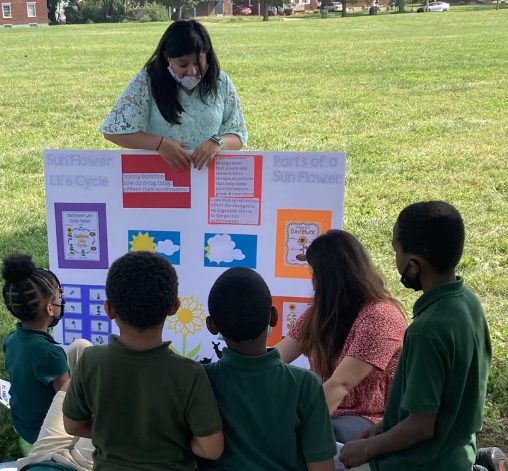
Laura Pirtle, a senior elementary education major at Wright State, teaching a science lesson to Westwood Elementary School students.
Wright State University education and medical students are learning through discovery alongside school students at Westwood Elementary School’s garden.
The partnership involves students from Wright State’s Teacher Education program and the Boonshoft School of Medicine who learn alongside elementary school students about topics such as the science of growing food and nutrition.
The collaboration began in 2018 when Westwood Elementary built the garden to encourage science education with its students and Wright State teacher education students.
The 200-square-foot area is filled with plants for pollinators and birds, vegetables and herbs that the students maintain.
The food grown in the garden goes back to the students and the community, said Colleen Saxen, Ed.D., assistant chair of teacher education. Students have made salads for their classmates, donated food to the House of Bread, a local soup kitchen and food pantry, and sent food home for families during the coronavirus pandemic.
Elementary education students, led by Michelle Fleming, Ph.D., associate professor of teacher education, prepare lessons and activities that use the garden as part of the science methods class.
Boonshoft School of Medicine students volunteer at the garden as part of the Public Health Alliance, a student-led organization. The medical students structure their lessons around nutrition education.
Saxen said the garden helps elementary education students to learn that they may receive questions that they may not know the answers to.
“The garden will give you lots of surprises. You may see worms or a cricket or a flower blooming you didn’t plan for,” Saxen said. “We work with our students to see it as a place to be curious, and that it’s OK to not know the answer to a question, and that’s a mind shift for all of us.”
Senior Laura Pirtle is one of around 60 elementary education students who have worked in the garden. She taught lessons about the way plants and animals grow, survive, behave and reproduce. She also taught the grade school students about how a changing environment can affect life.
She said working in the garden enabled her to be a better teacher.
“I was most excited to share my love for working in the garden with students because many of them have not had an experience working in or near a garden. I feel like it opened up a new appreciation for them,” Pirtle said. “I learned that a garden can be a wonderful teaching tool that I will continue to use once I get my own classroom.”
Amber Prater, an M.D. and Master of Public Health student in the Boonshoft School of Medicine, said she has pulled weeds and planted vegetables with students in the garden, but has also answered questions about medicine or going to the doctor. She said she also organizes nutrition-based activities.
Prater said that initially she felt nervous working with students, but she has grown to love going to the garden.
“Each time I go to the garden, I love to see the elementary students excited — and I mean genuinely excited — about nutrition, gardening and healthy eating,” Prater said. “As a gardener myself and a medical student, it is really rewarding to watch others build a healthy life and be enthusiastic about it too.”
Saxen said she is encouraged by seeing young people and students taking the lead on the garden. Elementary school students have offered suggestions for the garden and Wright State students take the lead when making changes.
“We get the voice and the ideas of the youngest participants,” Saxen said. “They lead the way in many ways. That’s the spirit of this project.”
Alongside the garden, Wright State is working with Westwood Right, a community project led by Dee Wooding that is working to revitalize the Westwood neighborhood. Westwood is in a food-insecure region of Dayton, and one aim of the Westwood Right project is to create more spaces to grow food for the community.

 Heavy metal learning
Heavy metal learning  State grants to bolster Wright State’s electric vehicle and advanced manufacturing training for students
State grants to bolster Wright State’s electric vehicle and advanced manufacturing training for students  Wright State partners with local universities, hospitals to expand mental health care for students
Wright State partners with local universities, hospitals to expand mental health care for students  Wright State students, first responders team up for Halloween event
Wright State students, first responders team up for Halloween event  Explore Wright State Day welcomes hundreds of future Raiders
Explore Wright State Day welcomes hundreds of future Raiders 